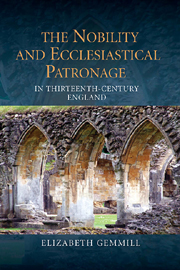Book contents
- Frontmatter
- Contents
- Acknowledgements
- List of Abbreviations
- Introduction
- Part I
- 1 Ecclesiastical Patronage Rights in the Thirteenth Century
- 2 The Exercise and Defence of Patronage Rights
- 3 Jobs for the Boys?
- Part II
- Conclusion
- Appendix of Documents
- Appendix of Magnate Presentations
- Bibliography
- Index
- Other volumes in Studies in the History of Medieval Religion
1 - Ecclesiastical Patronage Rights in the Thirteenth Century
from Part I
Published online by Cambridge University Press: 05 May 2013
- Frontmatter
- Contents
- Acknowledgements
- List of Abbreviations
- Introduction
- Part I
- 1 Ecclesiastical Patronage Rights in the Thirteenth Century
- 2 The Exercise and Defence of Patronage Rights
- 3 Jobs for the Boys?
- Part II
- Conclusion
- Appendix of Documents
- Appendix of Magnate Presentations
- Bibliography
- Index
- Other volumes in Studies in the History of Medieval Religion
Summary
Ecclesiastical patronage rights were property, belonging to and acquired with land. They belonged to the lord on whose estates the ecclesiastical institution – church or religious house – had been built, and from whom it had received its endowment. The rights that donors exercised in recognition of the gifts they had made descended with their estates. Broadly speaking, the patronage of a parish church was associated with the lordship of the manor in which the church was situated. The building of local churches between the tenth and twelfth centuries stemmed partly from the sense that ownership of a church was felt to confer status, although it is also true that such churches met the spiritual needs of ordinary people, enabling them to worship and to receive the sacraments of the Church within their own village communities. The patron of a church might be the lord of just one manor, but the more manors a lord had, the greater the number of churches he was likely to have in his gift. And, just as the establishment of a church on a local estate enhanced a local lord's standing, so the endowment of a religious house was associated with the acquisition of a larger fief. In particular, many religious houses in England were established by the companions of William the Conqueror or their descendants, often alongside their castles, so that both became symbols of their dominion and status.
- Type
- Chapter
- Information
- Publisher: Boydell & BrewerPrint publication year: 2013

